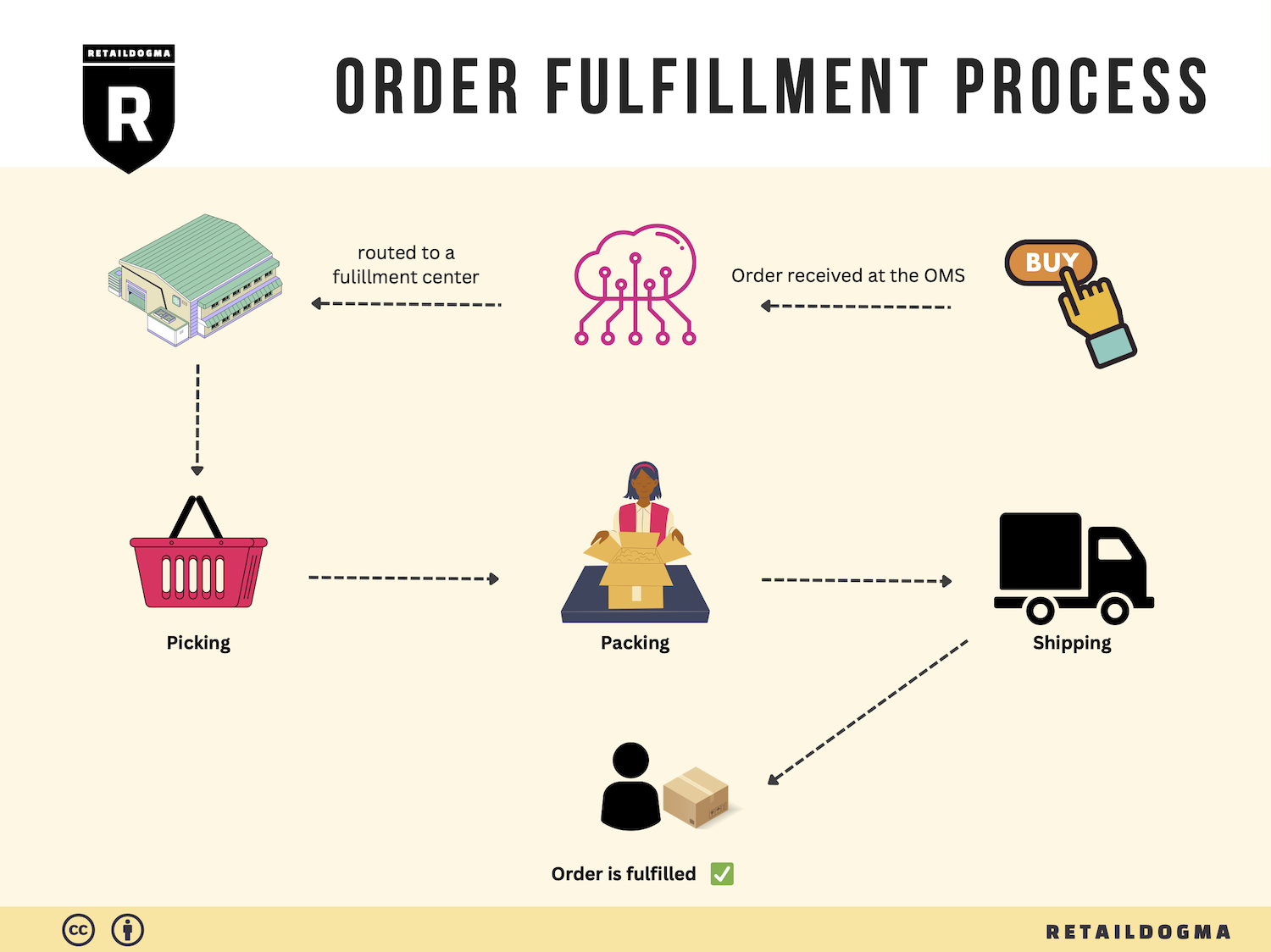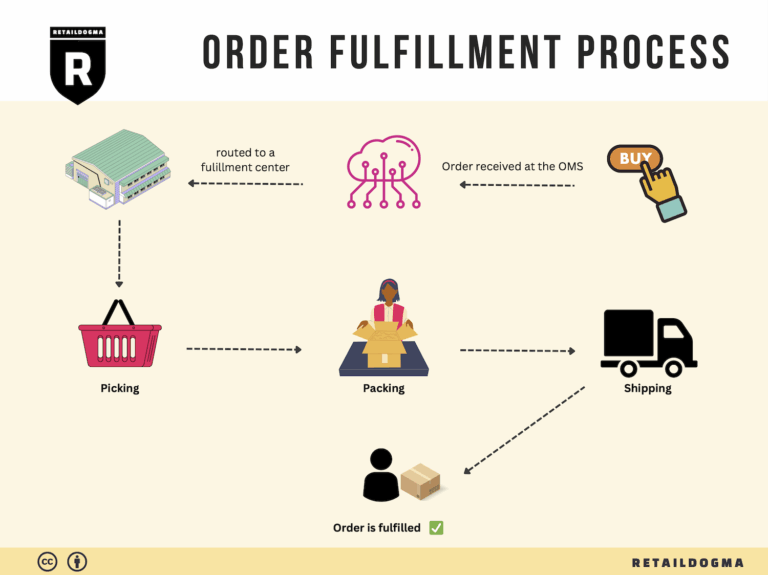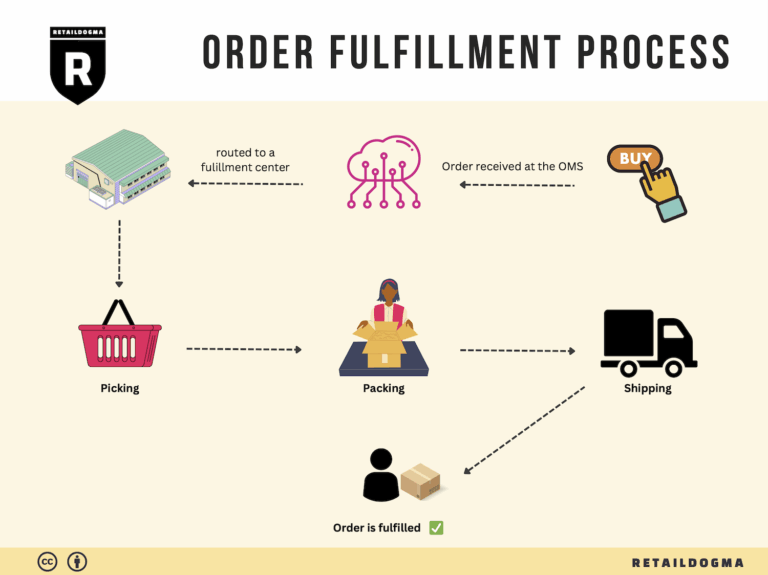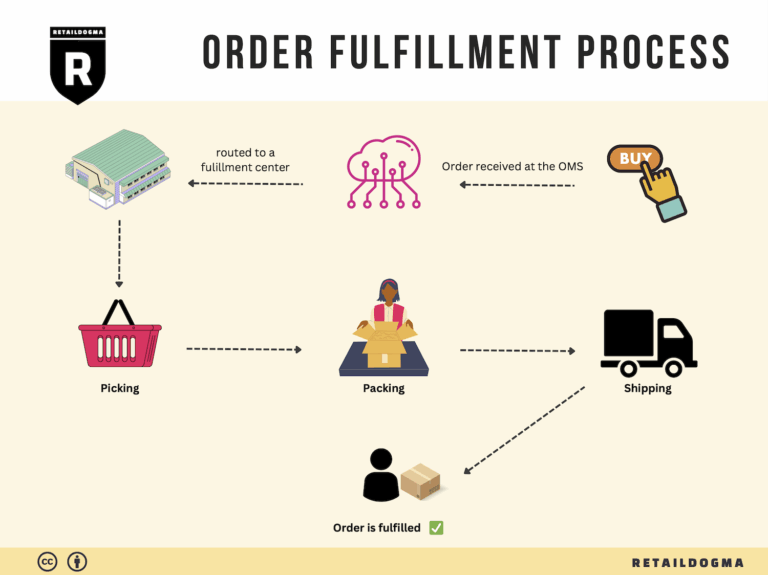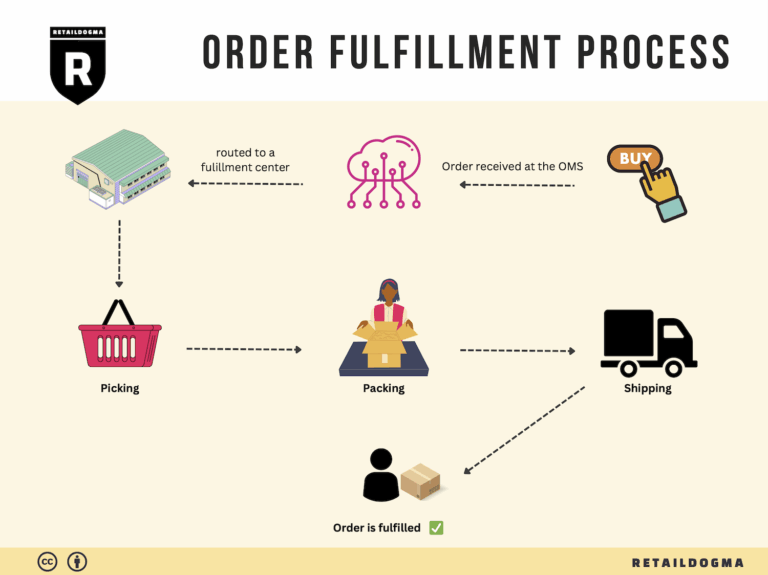How Order Fulfillment Works: A Step-by-Step Guide for Businesses
What is E-commerce Fulfillment? An Introduction for Growing Businesses
Overcoming the Packing and Shipping Overwhelm
As a growing e-commerce business, you may find yourself juggling multiple responsibilities—from marketing and customer service to managing inventory. Amidst this whirlwind, packing and shipping orders can feel like a monumental task. The reality is that fulfillment—the process of getting products into your customers’ hands—can quickly become overwhelming if not managed effectively. It’s not just about getting an order shipped; it’s about ensuring that each product is packaged, labeled, and delivered accurately and on time. Failure to do so can lead to dissatisfied customers and lost sales.
Understanding E-commerce Fulfillment
E-commerce fulfillment encompasses all the logistics involved in delivering products to customers. This includes everything from receiving and storing inventory to processing orders, packaging items, and coordinating shipping. For many businesses, outsourcing these tasks to a fulfillment center or a third-party logistics provider (3PL) can significantly streamline operations and allow you to focus on growing your business.
What This Guide Covers
In this guide, we will explore various e-commerce fulfillment models, including:
- Third-Party Logistics (3PL): These providers handle warehousing, order processing, and shipping on your behalf.
- Fulfillment by Amazon (FBA): A service that allows you to store your products in Amazon’s warehouses, where they take care of storage, packaging, and shipping.
We will delve into the core services offered by fulfillment centers, such as inventory management, order processing, and returns handling. Understanding these services will help you identify what you need from a fulfillment partner.
Next, we’ll provide practical advice on how to choose the right fulfillment partner for your business. This involves assessing factors such as location, technology integration, and service quality. We’ll also cover pricing structures, helping you navigate the various fees associated with fulfillment services, ensuring you can budget accordingly.
Empowering Your Logistics Decisions
The ultimate goal of this guide is to empower you—business owners, operations managers, and entrepreneurs—to make informed decisions about your e-commerce logistics. By understanding the ins and outs of fulfillment, you can enhance your operational efficiency, improve customer satisfaction, and drive business growth. With the right knowledge and resources at your disposal, you can transform fulfillment from a daunting task into a streamlined process that supports your business objectives.
What You’ll Learn In This Guide
- What is E-commerce Fulfillment? An Introduction for Growing Businesses
- The Order Fulfillment Process: From ‘Buy’ Button to Customer’s Door
- Comparing Fulfillment Models: In-House vs. 3PL vs. Dropshipping
- A Deep Dive into Amazon FBA: Pros, Cons, and Who It’s For
- Core Services Offered by Fulfillment Centers
- How to Choose a Fulfillment Partner: A 6-Point Checklist
- Understanding Fulfillment Pricing: A Breakdown of Common Fees
- Frequently Asked Questions (FAQs) about Fulfillment
- Conclusion: Is Outsourcing Fulfillment the Right Move for Your Business?
- Important Disclaimer
The Order Fulfillment Process: From ‘Buy’ Button to Customer’s Door
1. Receiving Inventory
The order fulfillment process begins with receiving inventory at the fulfillment center. When a business ships products to a fulfillment center, the items are checked against the shipment manifest to ensure accuracy. This step is crucial because it establishes the inventory baseline for the fulfillment operation.
Importance: Accurate receiving is vital for maintaining inventory integrity and preventing stock discrepancies. If items are miscounted or lost during this phase, it can lead to fulfillment errors down the line, affecting customer satisfaction.
Key Term: SKU (Stock Keeping Unit) – Each product is assigned a unique SKU, which simplifies tracking and management of inventory. This identifier is essential for accurate inventory management, ensuring that each product can be easily located in the warehouse.
2. Warehouse Storage
Once inventory is received, it is placed into warehouse storage. Fulfillment centers typically utilize an organized shelving system to maximize space and efficiency. Products are stored in a way that optimizes accessibility, often categorized by size, type, or sales velocity.
Importance: Efficient warehouse storage is critical for quick order processing. The more organized the storage, the faster the picking process can occur, which directly impacts shipping speed and customer satisfaction. Disorganized storage can lead to delays and fulfillment errors, as staff may struggle to locate items.
Key Term: FIFO (First In, First Out) – This inventory management method ensures that the oldest stock is sold first, reducing the risk of obsolescence and spoilage, particularly for perishable goods.
3. Order Picking
When a customer places an order on your e-commerce site, the next step in the fulfillment process is order picking. This involves retrieving the items from storage based on the order details. Fulfillment centers use various strategies for picking, including single order picking, batch picking, and zone picking.
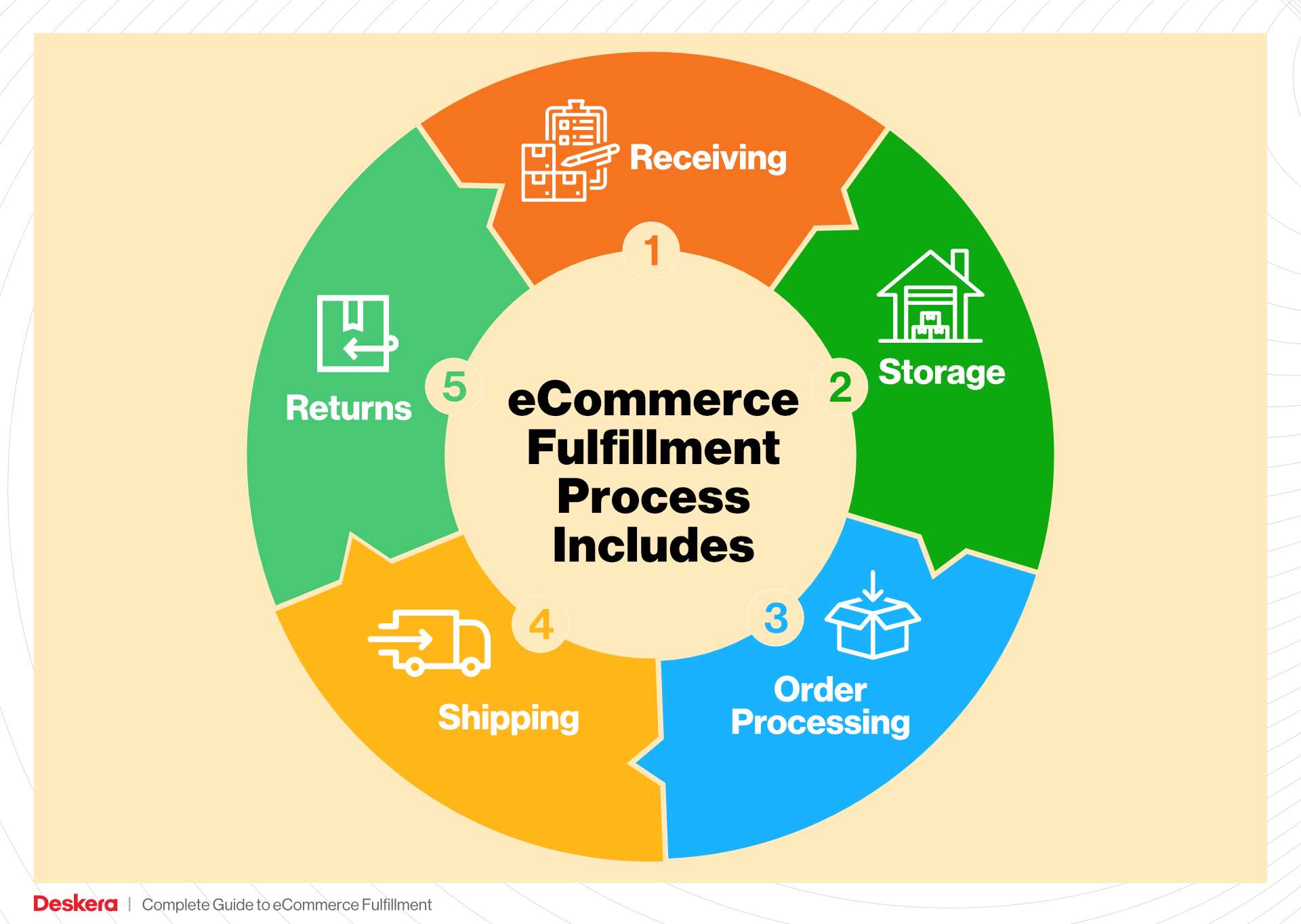
Importance: Efficient order picking is essential for timely order fulfillment. The faster and more accurately items are picked, the quicker they can be packed and shipped, leading to improved customer satisfaction. Errors during picking can result in wrong items being shipped, which can damage your brand’s reputation.
Key Term: Pick List – A document or digital tool that outlines the items to be retrieved for a specific order. It serves as a guide for the warehouse staff, ensuring that all items are collected accurately and efficiently.
4. Order Packing
After items are picked, they move to the order packing stage. Here, the items are carefully packaged for shipping. This includes selecting appropriate packaging materials, adding protective materials if necessary, and ensuring that the items are securely packed to prevent damage during transit.
Importance: Proper packing is crucial for protecting products during shipping and for providing a positive unboxing experience. A well-packed order not only reduces the likelihood of returns due to damage but can also enhance customer satisfaction through thoughtful presentation.
Key Term: Packing Slip – This document is included in the package and contains details about the order, such as items purchased, quantities, and the return policy. It serves as a reference for customers and aids in returns processing if needed.
5. Shipping & Delivery
The final step in the order fulfillment process is shipping and delivery. Once the order is packed, it is handed over to a shipping carrier, who will transport the package to the customer’s address. The choice of shipping provider and method can significantly impact delivery speed and costs.
Importance: Shipping and delivery are critical touchpoints for customer experience. Timely delivery is often a key factor in customer satisfaction and repeat purchases. Businesses must choose reliable shipping partners and offer various options, such as standard and expedited shipping, to meet diverse customer needs.
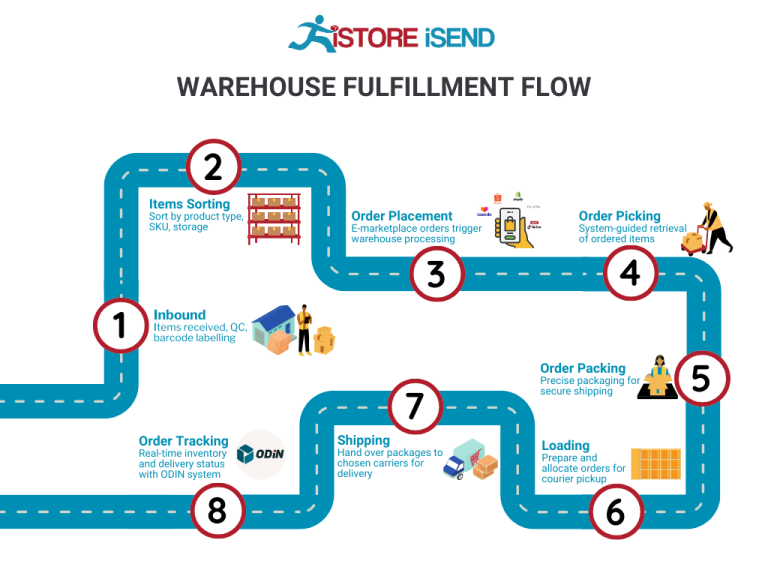
Key Term: Last Mile Delivery – This term refers to the final step of the shipping process, where the package is delivered from a transportation hub to the final customer location. Efficient last-mile delivery is essential for ensuring that customers receive their orders on time and in good condition.
By understanding and optimizing each of these steps in the order fulfillment process, e-commerce businesses can enhance efficiency, reduce costs, and ultimately improve customer satisfaction. Adopting best practices in fulfillment can be a game-changer for scaling your operations and maintaining a competitive edge in the market.
Comparing Fulfillment Models: In-House vs. 3PL vs. Dropshipping
Fulfillment Model Comparison
| Model | Who Handles Inventory | Best For (Business Stage) | Key Advantage | Key Disadvantage |
|---|---|---|---|---|
| In-House Fulfillment | The business itself | Startups and small businesses | Complete control over operations | High overhead costs |
| Third-Party Logistics (3PL) | Third-party provider | Growing businesses | Scalable and efficient operations | Less control over fulfillment |
| Dropshipping | Supplier or manufacturer | New entrepreneurs and niche markets | Low initial investment | Lower profit margins and control |
In-House Fulfillment
In-house fulfillment involves a company managing its entire order processing operation, including inventory management, packing, shipping, and handling returns. This model is typically favored by startups and small businesses that have the resources to manage their fulfillment processes. One of the primary advantages of in-house fulfillment is the level of control it provides. Businesses can oversee every aspect of the order fulfillment process, ensuring that quality standards are met, and they can customize packaging and personal touches to enhance customer experience. However, this model comes with significant drawbacks. Maintaining a warehouse for inventory storage, hiring staff, and managing logistics can lead to high overhead costs, which can be prohibitive for smaller businesses. Additionally, as order volumes grow, the in-house model may become less efficient, leading to potential delays and fulfillment errors that can harm customer satisfaction.
Third-Party Logistics (3PL)
Third-party logistics (3PL) is a fulfillment model where a business outsources its logistics and order fulfillment processes to a specialized provider. This option is ideal for growing businesses that need to scale quickly without investing heavily in infrastructure. The main advantage of using a 3PL provider is the scalability it offers. As order volumes increase, a 3PL can efficiently manage the logistics without the business needing to hire additional staff or invest in more warehouse space. 3PL providers typically have sophisticated technology and processes in place, allowing for faster order processing and shipping, which can enhance customer satisfaction. However, businesses using 3PL services may experience a loss of control over their fulfillment operations. If issues arise, such as shipping delays or inventory discrepancies, the business may have limited ability to intervene directly, which could lead to customer dissatisfaction. Additionally, there are ongoing costs associated with 3PL services that can accumulate over time.
Dropshipping
Dropshipping is a fulfillment model where a business sells products it does not keep in stock. Instead, when an order is placed, the business purchases the item from a third-party supplier who then ships it directly to the customer. This model is particularly appealing for new entrepreneurs and those in niche markets because it requires minimal upfront investment and eliminates the need for inventory management. The primary advantage of dropshipping is the low barrier to entry; entrepreneurs can start an online store without the financial burden of purchasing inventory upfront. Additionally, it allows for a wide range of products to be offered without the risk of overstocking. However, dropshipping also has significant disadvantages. Profit margins can be lower than other fulfillment models, as suppliers often charge higher prices per item. Furthermore, businesses have limited control over inventory levels and shipping times, which can lead to customer dissatisfaction if suppliers fail to deliver on time or if there are issues with product quality.
A Deep Dive into Amazon FBA: Pros, Cons, and Who It’s For
Understanding Fulfillment by Amazon (FBA)
Fulfillment by Amazon (FBA) is a service provided by Amazon that allows sellers to store their products in Amazon’s fulfillment centers. Amazon then takes care of storage, packaging, shipping, and customer service on behalf of the seller. This model has gained immense popularity among e-commerce businesses, particularly those looking to leverage Amazon’s vast logistics network and customer base.
How FBA Works
The process of using FBA is straightforward:
-
Setup and Inventory: Sellers create an Amazon seller account and set up FBA. They send their inventory to Amazon’s fulfillment centers, where the products are stored until sold.
-
Order Processing: When a customer places an order for a product listed by the seller, Amazon takes over. They pick, pack, and ship the product directly to the customer. This is done using Amazon’s highly efficient logistics and supply chain management systems.
-
Customer Service: Amazon also handles customer inquiries, returns, and refunds related to FBA orders, allowing sellers to focus on other aspects of their business.
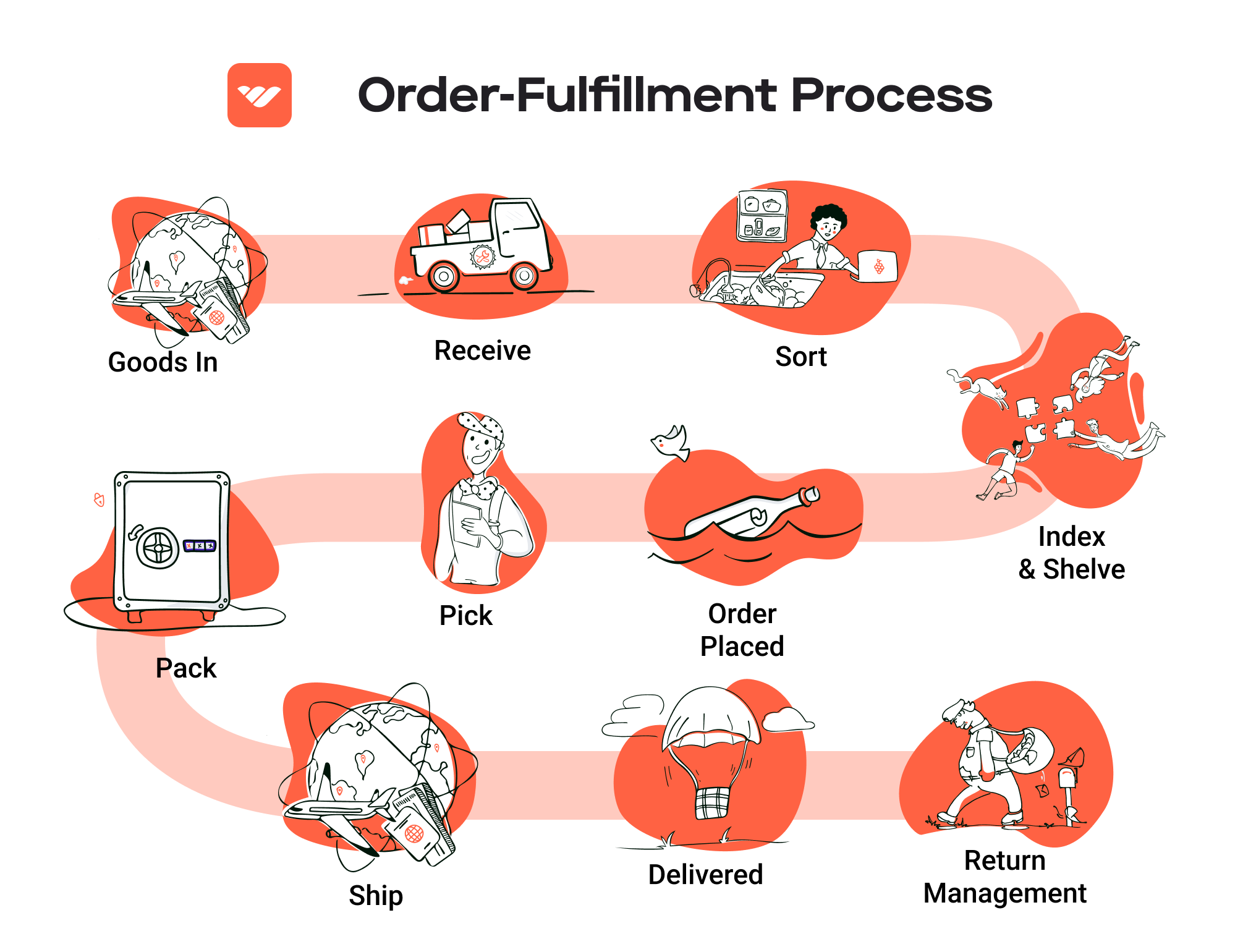
-
Tracking and Reporting: Sellers can monitor their inventory levels and sales performance through the Amazon Seller Central dashboard, providing real-time insights into their business operations.
Pros of Fulfillment by Amazon (FBA)
-
Prime Eligibility: Products fulfilled through FBA are automatically eligible for Amazon Prime, which can significantly increase sales due to the trust and preference consumers have for Prime shipping. This can lead to higher visibility and increased conversion rates.
-
Customer Trust: Selling through FBA enhances credibility. Customers often prefer buying from Amazon because of their established reputation for reliability and customer service. When sellers utilize FBA, they benefit from this trust, which can lead to increased sales.
-
Multi-Channel Fulfillment: FBA isn’t limited to Amazon’s marketplace. Sellers can also use FBA to fulfill orders from other sales channels, such as their own websites or other marketplaces. This provides flexibility and a streamlined logistics process across multiple platforms.
-
Scalability: FBA allows businesses to scale without the need to invest heavily in warehousing or logistics. As sales grow, sellers can easily send more inventory to Amazon without worrying about the physical infrastructure.
-
Time Savings: By outsourcing logistics to Amazon, sellers can focus on core business activities such as product development, marketing, and customer engagement, rather than the complexities of order fulfillment.
Cons of Fulfillment by Amazon (FBA)
-
High Fees: While FBA can simplify logistics, it comes with costs. Sellers must pay various fees, including storage fees for inventory and fulfillment fees for each order processed. These fees can add up quickly, especially for low-margin products.
-
Strict Inventory Rules: Amazon enforces strict guidelines regarding inventory management. Sellers must adhere to specific packaging, labeling, and shipping requirements, which can be burdensome for some businesses. Non-compliance may lead to additional charges or inventory being returned.
-
Commingling Risks: One of the notable risks of FBA is inventory commingling. Amazon may mix a seller’s inventory with that of other sellers, which can lead to issues if a customer receives a defective or damaged product. This can also complicate inventory tracking and accountability.
-
Lack of Control: Once inventory is sent to Amazon, sellers relinquish a degree of control over their fulfillment process. If issues arise—such as delays in shipping or errors in order processing—sellers may find it challenging to resolve them quickly.
-
Potential for Long-Term Commitment: The nature of FBA can create dependency. Sellers may find it difficult to switch to other fulfillment methods due to the integration with Amazon’s systems and the established customer base.
Who is FBA Best For?
Fulfillment by Amazon is particularly beneficial for:
-
Small to Medium-Sized Businesses: Those looking to scale quickly without investing heavily in logistics infrastructure can greatly benefit from FBA’s efficiency and reach.
-
E-commerce Entrepreneurs: New sellers who want to tap into Amazon’s vast customer base and trust can leverage FBA to gain a competitive edge.
-
Sellers with High Inventory Turnover: Businesses that sell products with a high turnover rate can maximize their profits by utilizing Amazon’s logistics capabilities.
-
Brands Focused on Growth: Companies that prioritize growth and brand visibility can take advantage of FBA’s Prime eligibility and customer trust.
-
Multi-Channel Retailers: Businesses selling on multiple platforms can benefit from the streamlined fulfillment process that FBA offers.
In conclusion, while FBA can offer immense advantages for e-commerce businesses, it’s essential to weigh these against the potential drawbacks. Understanding the intricacies of FBA will help sellers make informed decisions about their fulfillment strategies, ensuring they align with their business goals and customer expectations.
Core Services Offered by Fulfillment Centers
Inventory Management & Warehousing
Fulfillment centers provide comprehensive inventory management and warehousing solutions that enable e-commerce businesses to optimize their stock levels and storage capabilities. This service encompasses receiving products, storing them in an organized manner, and keeping track of inventory levels through advanced inventory management systems.
Benefits:
– Cost Efficiency: By outsourcing warehousing to a fulfillment center, e-commerce businesses can avoid the high costs associated with maintaining their own storage facilities, including rent, utilities, and staffing.
– Space Optimization: Fulfillment centers are equipped to handle large volumes of inventory, allowing businesses to scale their operations without worrying about physical space limitations.
– Real-time Tracking: Most fulfillment centers utilize sophisticated software that provides real-time inventory tracking, ensuring businesses have accurate information on stock levels. This capability is crucial for avoiding stockouts or overstock situations, which can negatively impact sales and customer satisfaction.
– Reduced Complexity: Managing inventory across multiple locations can be challenging. Fulfillment centers centralize this process, simplifying operations and providing businesses with a clear overview of their inventory status.
Pick and Pack Services
The pick and pack service is a core function of fulfillment centers that involves selecting items from inventory and preparing them for shipment to customers. This process includes picking the right products, packing them securely, and labeling them for delivery.
Benefits:
– Efficiency: Fulfillment centers employ trained staff and automated systems to streamline the picking process, significantly reducing the time it takes to fulfill orders. This speed translates to faster delivery times, enhancing customer satisfaction.
– Accuracy: With a focus on accuracy, fulfillment centers implement quality control measures to minimize picking errors. This attention to detail helps maintain customer trust and reduces the costs associated with returns and exchanges.
– Scalability: As e-commerce businesses grow, order volumes can fluctuate. Fulfillment centers can easily scale their pick and pack operations to accommodate spikes in demand, such as during holiday seasons or promotional events, without requiring businesses to hire additional staff.
– Customization Options: Many fulfillment centers offer flexible packing options, allowing businesses to include branded packaging or promotional materials, enhancing the customer experience and reinforcing brand identity.
Kitting and Assembly
Kitting and assembly services involve grouping individual items into ready-to-ship sets or preparing products for sale. This service is particularly beneficial for e-commerce businesses that sell bundled products or require assembly before shipping.
Benefits:
– Enhanced Product Offerings: By offering kitted products, businesses can create unique bundles that appeal to customers, potentially increasing average order value and customer satisfaction.
– Time Savings: Outsourcing the kitting and assembly process to a fulfillment center allows e-commerce businesses to save time and focus on core activities such as marketing and customer service, rather than manual assembly tasks.
– Quality Control: Fulfillment centers often have specialized teams that ensure kitting and assembly is done accurately and to high standards, reducing the likelihood of errors that could lead to customer dissatisfaction.
– Efficient Inventory Management: Kitting allows businesses to manage inventory more effectively by consolidating various components into a single SKU. This simplifies inventory tracking and can lead to improved stock management.
Returns Management (Reverse Logistics)
Returns management, often referred to as reverse logistics, is an essential service provided by fulfillment centers that handles the processing of returned items. This includes receiving returned products, inspecting them for damage, restocking them if applicable, and managing the associated customer communications.
Benefits:
– Streamlined Process: Fulfillment centers have established procedures for managing returns, ensuring that the process is efficient and minimizes the impact on the business’s operations. This efficiency is critical for maintaining customer satisfaction, as a smooth returns process can enhance customer loyalty.
– Cost Management: By outsourcing returns management, e-commerce businesses can reduce the costs associated with handling returns in-house, such as labor and processing time. Fulfillment centers can often negotiate better shipping rates for return labels, further lowering expenses.
– Data Insights: Fulfillment centers often provide analytics on returns, helping businesses identify trends and reasons for returns. This data can be invaluable for improving product offerings and addressing potential issues before they affect sales.
– Customer Experience: A well-managed returns process can significantly improve the customer experience, making it more likely that customers will return for future purchases. In today’s e-commerce environment, a hassle-free returns policy is often a key factor in a customer’s decision to buy.
By leveraging these core services offered by fulfillment centers, e-commerce businesses can enhance their operational efficiency, reduce costs, and ultimately improve customer satisfaction. As a result, they can focus on scaling their operations and driving growth in a competitive marketplace.
How to Choose a Fulfillment Partner: A 6-Point Checklist
Location & Warehouse Network
Why It Matters:
The location of your fulfillment partner’s warehouses is critical for minimizing shipping times and costs. A fulfillment center situated near your primary customer base can significantly enhance delivery speed and reduce shipping expenses, which directly impacts customer satisfaction.
Questions to Ask:
– Where are your warehouses located, and how do they align with my target market?
– Do you have multiple locations to facilitate faster delivery across different regions?
– How do you manage inventory across various locations to ensure optimal stock levels?
Technology & Integrations
Why It Matters:
Efficient order processing relies heavily on technology. Your fulfillment partner should offer robust systems that seamlessly integrate with your e-commerce platform. This integration minimizes manual errors and streamlines the order fulfillment process, allowing for real-time inventory tracking and order updates.
Questions to Ask:
– What technology do you use for order processing and inventory management?
– Can your system integrate with my current e-commerce platform? What are the steps involved?
– Do you offer real-time tracking for orders, and how do you communicate updates to customers?
Specializations (e.g., Cold Storage, Oversized Items)
Why It Matters:
Depending on your product offerings, you may need a fulfillment partner with specific capabilities. If you sell perishable goods, for instance, a partner with cold storage facilities is essential. Similarly, if your products are oversized or require special handling, ensure the fulfillment center can accommodate these needs.
Questions to Ask:
– What types of products do you specialize in handling? Are there any limitations?
– Do you have facilities for specialized storage (e.g., temperature control, hazardous materials)?
– How do you ensure the safe handling and storage of delicate or oversized items?
Scalability & Capacity
Why It Matters:
As your business grows, your fulfillment needs will likely change. A good fulfillment partner should be able to scale with you, whether you’re experiencing seasonal spikes in demand or significant growth. Ensuring that they have the capacity to handle increased order volumes without compromising service quality is crucial.
Questions to Ask:
– How do you handle peak seasons or unexpected spikes in order volume?
– What is your current capacity, and how can it be expanded if needed?
– Can you provide examples of how you’ve managed scaling for other clients?
Pricing and Contracts
Why It Matters:
Understanding the cost structure of your fulfillment partner is essential for maintaining healthy profit margins. Be clear about all potential fees, including storage, order processing, and shipping costs. Additionally, review contract terms to ensure they align with your business model and growth plans.
Questions to Ask:
– Can you provide a detailed breakdown of your pricing structure?
– Are there any hidden fees I should be aware of (e.g., for returns, special handling)?
– What are the terms of the contract? Is there flexibility for renegotiation as my business evolves?
Customer Support & Reviews
Why It Matters:
Effective customer support is vital for resolving issues quickly and maintaining a good relationship with your fulfillment partner. Additionally, researching reviews and testimonials can provide insights into their reliability and service quality, which can be pivotal in times of crisis.
Questions to Ask:
– What level of customer support can I expect? Is it available 24/7?
– How do you handle issues such as shipping errors or inventory discrepancies?
– Can you provide references or case studies from current or past clients?
Conclusion
Choosing the right fulfillment partner is a strategic decision that can significantly impact your e-commerce business. By following this checklist and asking the right questions, you can ensure that you select a partner that aligns with your operational needs and growth ambitions. Remember, the ideal fulfillment partner should not only meet your current requirements but also support your future growth and enhance your customers’ experience.
Understanding Fulfillment Pricing: A Breakdown of Common Fees
Initial Setup Fees
When engaging a fulfillment center, the first cost you will encounter is the initial setup fee. This fee covers the onboarding process, which may include integrating your e-commerce platform with the fulfillment provider’s system, training your staff on how to use the new system, and customizing the fulfillment workflow to suit your business needs.
The setup fee can vary widely, ranging from a few hundred to several thousand dollars, depending on the complexity of the integration and the specific requirements of your business. Factors influencing the cost include the number of SKUs, the level of customization needed, and the provider’s technology. Ensure you clearly understand what the setup fee entails, as some providers may charge additional costs for certain integrations or training sessions.
Receiving Fees
Receiving fees are charged when your inventory arrives at the fulfillment center. This fee typically covers the process of unloading, inspecting, and storing your products in the warehouse.
Receiving fees are usually calculated based on the number of pallets or boxes received. For example, a fulfillment center might charge a flat fee per pallet or a per-item fee if the products are unpacked individually. It’s essential to ask about potential additional charges for special handling or inspection services, as these can significantly impact your overall fulfillment costs.
Storage Fees (per pallet/bin)
Storage fees are incurred for keeping your inventory in the fulfillment center. These fees can be charged on a per-pallet or per-bin basis, and they usually vary based on the size and weight of your products.
Monthly storage fees are typically calculated based on the total volume of space your inventory occupies. For instance, if your products take up five pallets, and the storage fee is $20 per pallet, your monthly storage cost would be $100.
It’s worth noting that some fulfillment centers may have a minimum storage fee or charge for a specific storage period (e.g., monthly or quarterly). Additionally, be aware of any extra charges that may apply if your inventory remains unsold for an extended period, commonly referred to as “long-term storage fees.”
Pick & Pack Fees (per item/order)
Pick and pack fees are charged for the process of selecting items from inventory (picking) and preparing them for shipment (packing). This fee is crucial as it directly correlates to the fulfillment center’s labor costs involved in processing your orders.
Pick and pack fees can vary based on several factors, including the number of items per order and the complexity of the packing process. Typically, fulfillment centers charge a flat fee per order or a per-item fee. For example, if a fulfillment center charges $1.50 per item and you have an order of three items, the total pick and pack fee would be $4.50.
It’s advisable to clarify whether the pick and pack fee includes additional services such as gift wrapping or special packaging, as these may incur extra charges.
Shipping Fees
Shipping fees represent one of the most significant costs in the fulfillment process. These fees are charged for the actual shipping of your products from the fulfillment center to your customers.
Shipping fees are calculated based on various factors, including the weight and dimensions of the package, the shipping method selected (standard, expedited, etc.), and the destination. Many fulfillment centers have partnerships with shipping carriers, allowing them to offer discounted rates, which can be beneficial for your business.
When considering shipping fees, be mindful of how they will impact your pricing strategy. You may choose to absorb these costs, pass them onto customers, or offer free shipping above a certain order threshold. Understanding the shipping costs upfront is crucial for maintaining your profit margins and ensuring customer satisfaction.
Tips for Getting an Accurate Quote
-
Provide Detailed Information: When requesting quotes from fulfillment centers, provide comprehensive details about your products, including dimensions, weight, and the average number of orders you expect monthly.
-
Ask About Hidden Fees: Inquire about any additional fees that may not be included in the initial quote, such as long-term storage fees, inventory handling fees, or charges for special packing requests.
-
Compare Multiple Providers: Don’t settle for the first quote you receive. Compare offers from various fulfillment centers to ensure you’re getting the best value for your business needs.
-
Negotiate Terms: Many fulfillment providers are open to negotiation, especially if you’re bringing them a significant volume of business. Discuss potential discounts or package deals that could lower your overall costs.
-
Review Service Agreements: Carefully read the service agreements before signing, ensuring you understand all terms related to fees, service levels, and responsibilities.
By thoroughly understanding the common fees associated with fulfillment centers and how they are calculated, you can make informed decisions that align with your business strategy and budget.
Frequently Asked Questions (FAQs) about Fulfillment
1. What is a fulfillment center?
A fulfillment center is a third-party logistics provider that manages the storage, processing, and shipping of products for e-commerce businesses. When a customer places an order, the fulfillment center picks, packs, and ships the product directly to the customer, allowing the seller to focus on other aspects of their business.
2. How does a fulfillment center work?
To utilize a fulfillment center, e-commerce businesses store their inventory at the center. When an order is received, the fulfillment center is notified and retrieves the ordered item, packages it, and ships it using their partnered carriers. The seller remains the point of contact for the customer throughout the process.
3. What is the difference between a warehouse and a fulfillment center?
A warehouse primarily serves as a storage facility where products are kept long-term without the immediate need for shipping. In contrast, a fulfillment center focuses on the rapid processing and shipping of orders, handling tasks such as picking, packing, and logistics, which are essential for e-commerce operations.
4. What is a 3PL?
A 3PL, or third-party logistics provider, is a service that manages logistics operations on behalf of a business. This includes warehousing, transportation, and fulfillment services. Fulfillment centers can be considered a type of 3PL, as they specifically handle the logistics of order fulfillment for e-commerce companies.
5. How much do fulfillment services cost?
Fulfillment costs vary widely based on factors such as order volume, storage needs, and specific services provided. Typically, businesses can expect to pay a combination of storage fees, fulfillment fees per order, and shipping costs. It is crucial to obtain quotes from multiple providers to find a service that fits your budget.
6. What are the advantages of using a fulfillment center?
Using a fulfillment center offers several advantages, including reduced overhead costs (no need for a physical storefront), faster order processing and shipping, access to advanced logistics technology, and the ability to scale operations without the need for additional staffing.
7. What are the disadvantages of using a fulfillment center?
Some drawbacks include potential loss of control over the fulfillment process, the cost of services that can eat into profit margins, and limitations on customization of orders. Additionally, delays in inventory replenishment can lead to stockouts and order fulfillment issues.
8. How can I choose the right fulfillment center for my business?
When selecting a fulfillment center, consider factors such as location (to minimize shipping times), technology integration with your e-commerce platform, service offerings, pricing structure, and customer reviews. It’s essential to assess whether the provider can meet your specific needs for order volume and product types.
9. What types of fulfillment methods are available?
There are several fulfillment methods, including in-house fulfillment (managing orders internally), outsourced fulfillment (using a third-party provider), hybrid fulfillment (a combination of both), and dropshipping (where the supplier ships directly to the customer without the seller holding inventory).
10. How can fulfillment centers impact customer satisfaction?
Efficient fulfillment centers can significantly enhance customer satisfaction by ensuring timely and accurate order delivery, reducing shipping costs, and providing tracking information. A positive fulfillment experience fosters customer loyalty and encourages repeat business, essential for scaling e-commerce operations.
Conclusion: Is Outsourcing Fulfillment the Right Move for Your Business?
Assessing the Value of Outsourcing Fulfillment
Outsourcing fulfillment can be a game changer for e-commerce businesses aiming for growth and efficiency. By leveraging a fulfillment service, you can save significant time that would otherwise be spent on inventory management, order processing, and shipping logistics. This efficiency allows you to focus on core business activities such as marketing, product development, and customer engagement, ultimately enhancing your overall strategic initiatives.
Scalability is another key advantage. As your business grows, so do your order volumes. Fulfillment centers are designed to handle fluctuating demand, allowing you to seamlessly scale operations without the need for heavy investments in infrastructure or staff. This flexibility means you can quickly adapt to market changes or seasonal spikes in demand, ensuring that you remain competitive and responsive to your customers’ needs.
Moreover, partnering with a fulfillment service grants you access to industry expertise and advanced logistics technology. These providers often have established networks that can offer better shipping rates and faster delivery times than you could achieve on your own. Their experience in handling returns, inventory management, and order accuracy can significantly enhance customer satisfaction and loyalty.
However, the success of outsourcing fulfillment hinges on selecting the right partner. It’s crucial to evaluate potential providers based on their location, service offerings, and ability to integrate with your existing systems. Conduct thorough research and consider conducting a trial to assess their performance before committing fully.
To determine if outsourcing fulfillment is the right next step for your business, conduct a comprehensive audit of your current shipping processes. Identify pain points, assess costs, and evaluate your capacity for growth. This analysis will provide clarity on whether a fulfillment partner can help you achieve your business objectives more efficiently. Take this strategic step to position your e-commerce business for sustainable success.
Important Disclaimer
⚠️ Important Disclaimer
The information in this guide is for educational purposes. Fulfillment services, pricing, and platform features change frequently. Always conduct your own due diligence and consult with providers directly before making business decisions.
